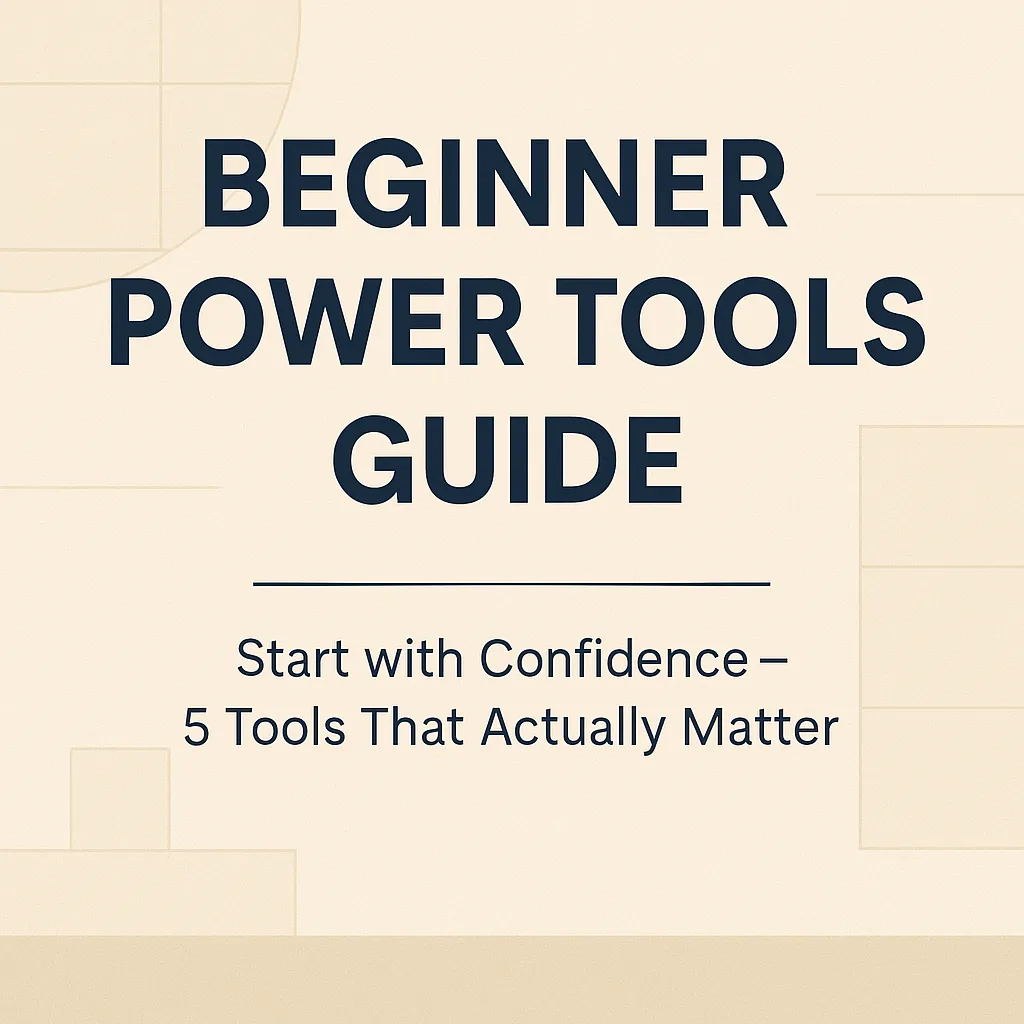New! DIY Project Planner. Plan smarter, skip the spreadsheets. Start Your Free Trial Today →

If you’re new to home improvement, this beginner power tools guide is your fast track to doing things right—from the start. Because let’s face it: walking into a hardware store as a first-timer feels more like stepping onto a spaceship than into a helpful aisle.
Cordless drills, jigsaws, orbital sanders—where do you even begin?
Right here.
This guide walks you through the tools that actually get used (not just collect dust), how to use them without wrecking your project, what to skip until later, and how to get confident fast. It’s not about buying more—it’s about knowing what matters.
There are two types of beginner mistakes when it comes to tools:
Both lead to the same problem: wasted money, low confidence, and stalled projects.
That’s what we’re avoiding. Instead, we’re going to focus on:
Let’s start with your core toolkit.
Heads up: Some of the links below are affiliate links. That means if you buy through them, we might earn a small commission (at no extra cost to you). We only recommend tools we trust and actually use.
These aren’t bells and whistles. These are the tools that will carry you through wall-mounting, basic carpentry, paint prep, flooring, and weekend fixes without fail.
Use it for: Installing shelves, assembling furniture, drilling pilot holes, light woodworking
Why you need it: This tool replaces screwdrivers entirely and lets you anchor into studs, pre-drill for clean finish nails, and hang anything heavy with ease.
What to look for: Variable speed, 18V or 20V battery, comfortable grip, and clutch control
See our post: Best Cordless Drills Under $150
Recommended product: DEWALT 20V MAX Drill/Driver Kit
Got a drill? These projects are quick, practical, and surprisingly impactful.
Use it for: Prepping walls for paint, smoothing wood, furniture restoration, light finishing work
Why you need it: Most beginner projects involve sanding—even if it’s just a patch of wall. A good orbital sander saves hours and delivers a smoother finish than sanding blocks.
What to look for: Hook-and-loop pad, dust bag or vac port, easy pad changes
See our guide: Paint Like a Pro
Recommended product: BLACK+DECKER 5-Inch Random Orbit Sander
Use it for: Cutting wood boards, shelves, trim pieces, or plywood into curves and straight lines
Why you need it: A jigsaw is versatile, safe, and beginner-friendly—ideal for floating shelves, closet projects, or light furniture work.
What to look for: Tool-less blade changes, speed control, orbital cutting option
Try it with our Floating Shelves Guide
Recommended product: BOSCH JS260 Top-Handle Jigsaw
Use it for: Cutting door trim, plunge cuts in drywall, sanding corners, scraping caulk or grout
Why you need it: This is the tool that gets you out of weird, tight spots no other tool fits into. It’s a favorite for flooring prep, patching walls, and demo clean-up.
What to look for: Tool-free blade changes, variable speed, quality blades included
Use it during your Laminate Flooring Install
Recommended product: DEWALT 20V MAX XR Oscillating Tool Kit
Use it for: Cleaning sanding dust, wet spills, sawdust, and work messes
Why you need it: A clean space is a safe space. Shop vacs are essential for sanding, cutting, and paint prep—and they do double-duty in garages or basements.
What to look for: Wet/dry capacity, blower port, hose attachments
Essential for jobs like our Tile Backsplash Guide
Recommended product: Dewalt 5-Gallon Wet/Dry Vac
Let’s make it real. Here are projects that use these exact tools—and build your confidence:
These aren’t just tasks—they’re lessons. Each one builds a core DIY skill that unlocks bigger projects.
Start safe, stay safe. Power tools aren’t dangerous when used properly—but if you skip the basics, things can go sideways fast.
We’re working on a printable beginner safety checklist—stay tuned.
Some tools sound impressive but create more problems than they solve when you’re just starting out. Here’s what to skip:
❌ Table saws – Powerful, but risky without training
❌ Routers – Precise, but unnecessary unless you’re doing detailed woodwork
❌ Rotary/Dremel tools – Too specialized for most first-time tasks
❌ Nail guns – Easy to misuse; a hammer works fine for most early builds
❌ Angle grinders – Loud, aggressive, and not used in most indoor DIY work
These are advanced tools you’ll grow into—don’t clutter your workspace or budget with them just yet.
It’s tempting to grab the cheapest drill or the fanciest brand kit—but performance, safety, and compatibility matter more.
Here’s what to prioritize:
Need a broader checklist? See our full post: Tools We Recommend
The biggest mistake beginners make isn’t buying the wrong tool—it’s buying it and never using it.
Here’s how to actually learn:
Confidence doesn’t come from watching YouTube or scrolling Pinterest. It comes from driving the screw, cutting the board, and fixing the problem—yourself.
Bookmark this beginner power tools guide, explore our project library, and start small. Because once you finish one real project, you’re not a beginner anymore.
You’re a DIYer.